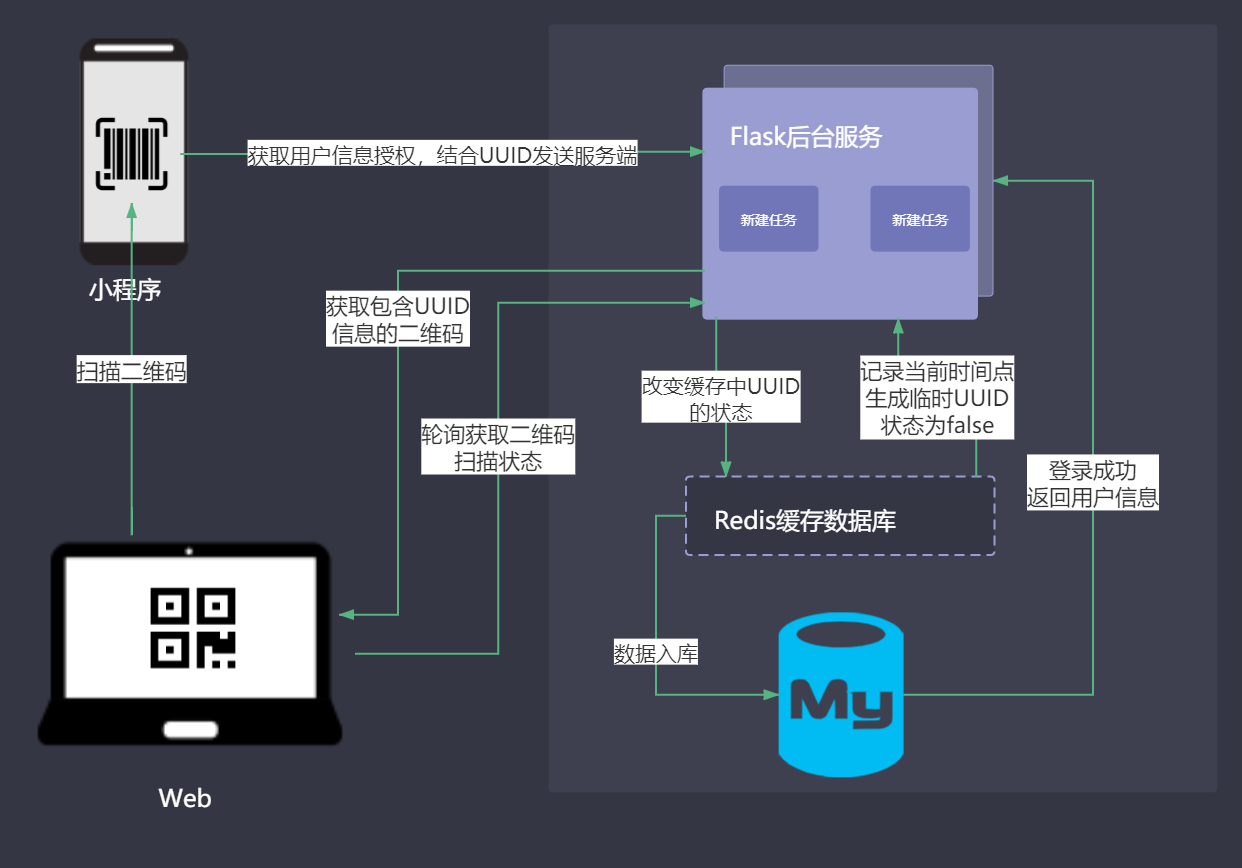通过手机微信扫码登陆,对用户来说是个十分便捷的功能,然而官方只对企业认证用户开放了接口,不过我们可以通过曲线救国的方式实现该功能。
背景
我有一个管理系统,希望只有我指定的人才能登陆使用,然而账号密码是会丢失的。所以手机微信扫码登陆成了我首选,不过没有企业认证用不了官方的接口。
还好,我也有自己的微信小程序,可以通过小程序来实现该功能。
系统架构

核心代码
服务端
服务端我采用的Flask框架,因为生成二维码很频繁且对即时性要求较高,我采用的Redis缓存数据库来记录。
1
2
3
4
5
6
7
8
| '''
Redis配置
'''
app.config['REDIS_HOST'] = "127.0.0.1"
app.config['REDIS_PORT'] = 6379
app.config['REDIS_DB'] = 0
app.config['REDIS_EXPIRE'] = 60
|
每次用户打开web端的二维码登陆界面,都会触发服务端去生成一个以UUID为key的缓存数据存入redis,且为未登录状态
1
2
3
4
5
6
7
8
9
| @login.route("/qrlogin", methods=["GET", "POST"])
def qrlogin():
uid = getUnquieUUID()
setTime = int(round(time.time() * 1000))
setUUIDStatus(uid, 0, None, setTime)
qrcode_str = set_qrcode(url="{0}".format(uid))
return make_response(jsonify({'code': 0, 'content': {'loginCode': qrcode_str.decode('utf-8'), 'loginId': uid}, 'msg': ''}))
|
小程序端提供一个扫码入口,扫指定的信息后,可以连同小程序中获取的用户信息一起发送给服务端,服务端根据信息中key及用户信息,来校验,并入库保存信息。
1
2
3
4
5
6
7
8
9
10
11
12
| @login.route("/accpetLogin", methods=["GET", "POST"])
def accpetLogin():
uuid = request.json.get('uuid')
userName = request.json.get('userName')
uuInfo = getUUIDInfo(uuid)
if not uuInfo:
return make_response(jsonify({'code': 10002, 'content': {}, 'msg': '别偷东西!'}))
nowTime = int(round(time.time() * 1000))
if nowTime - uuInfo['setTime'] > 300000:
return make_response(jsonify({'code': 10002, 'content': {}, 'msg': '验证码已失效,请刷新重新扫描!'}))
setUUIDStatus(uuid, 1, userName, nowTime)
return make_response(jsonify({'code': 0, 'content': {}, 'msg': '登录成功!'}))
|
web页面会一直轮询检查该二维码的扫码状态,如果被扫成功了,则会带着扫码人信息进入应用。
1
2
3
4
5
6
7
8
9
10
11
12
| @login.route("/getCodeStatus", methods=["POST"])
def getCodeStatus():
uuid = request.json.get('loginId')
uuInfo = getUUIDInfo(uuid)
if not uuInfo:
return make_response(jsonify({'code': 10002, 'content': {}, 'msg': '别偷东西!'}))
if uuInfo['status'] == 1:
return make_response(jsonify({'code': 0, 'content': {'userName': uuInfo['userName']}, 'msg': '登录成功!'}))
nowTime = int(round(time.time() * 1000))
if nowTime - uuInfo['setTime'] > 300000:
return make_response(jsonify({'code': 10002, 'content': {}, 'msg': '验证码已失效,请刷新重新扫描!'}))
return make_response(jsonify({'code': 10002, 'content': {}, 'msg': '等待验证!'}))
|
web端
web主要是取做获取验证码和检查验证状态,我用的是DVA,处理方法主要在models里。
前端的事件:
1
2
3
4
5
6
7
8
9
10
11
12
13
14
15
16
17
18
19
20
21
22
23
24
25
| queryGetLoginQr = () => {
const { dispatch } = this.props;
dispatch({
type: 'login/queryGetLoginQr',
})
.then(() => {
const { userLogin: { codeInfo } } = this.props;
this.setState({ codeInfo }, () => {
this.Timer = setInterval(() => {
this.queryGetCodeStatus()
}, 1000);
})
})
};
queryGetCodeStatus = () => {
const { dispatch } = this.props;
const { userLogin: { codeInfo } } = this.props;
dispatch({
type: 'login/queryGetCodeStatus',
payload: {
loginId: codeInfo.loginId,
},
})
}
|
models:
1
2
3
4
5
6
7
8
9
10
11
12
13
14
15
16
17
18
19
20
21
22
23
24
25
26
27
28
29
30
31
| *queryGetLoginQr({ payload }, { call, put }) {
yield put({ type: 'updateState', payload: { loginCode: null } });
const res = yield call(queryGetLoginQr, payload);
if (res) {
yield put({ type: 'updateState', payload: { codeInfo: res.content } });
}
},
*queryGetCodeStatus({ payload }, { call, put }) {
yield put({ type: 'changeLoginStatus', payload: { status: 'err', currentAuthority: 'guest' } });
const res = yield call(queryGetCodeStatus, payload);
if (res && res.code === 0) {
yield put({ type: 'changeLoginStatus', payload: { status: 'ok', currentAuthority: 'admin' } });
const urlParams = new URL(window.location.href);
const params = getPageQuery();
let { redirect } = params;
if (redirect) {
const redirectUrlParams = new URL(redirect);
if (redirectUrlParams.origin === urlParams.origin) {
redirect = redirect.substr(urlParams.origin.length);
if (redirect.match(/^\/.*#/)) {
redirect = redirect.substr(redirect.indexOf('#') + 1);
}
} else {
window.location.href = '/';
return;
}
}
yield put(routerRedux.replace(redirect || '/'));
}
},
|
小程序端
小程序端是比较简陋的demo,不用在意样式,核心就是扫码获取信息。我用的Taro框架,还是react语法。
其中的允许登录按钮应该结合获取用户信息的type来写,需要的自己完善下。
1
2
3
4
5
6
7
8
9
10
11
12
13
14
15
16
17
18
19
20
21
22
23
24
25
26
27
28
29
30
31
32
33
| handleScan = () => {
Taro.scanCode()
.then(res =>{
this.setState({uuid: res.result});
})
}
handleAccpetLogin = () => {
const { uuid } = this.state;
const { dispatch } = this.props;
dispatch({
type: 'system/queryAccpetLogin',
payload: {
uuid,
userName: 'laochen'
}
})
}
render () {
const { uuid } = this.state;
return (
<View className='index'>
{uuid && (
<Text>是否允许PC端登录?</Text>
)}
<Button onClick={()=>this.handleScan()}>扫码</Button>
{uuid && (
<Button onClick={()=>this.handleAccpetLogin()} type='primary'>允许登录</Button>
)}
</View>
)
}
|
结束
项目完整代码:https://github.com/t880216t/wxQrloginWeb
